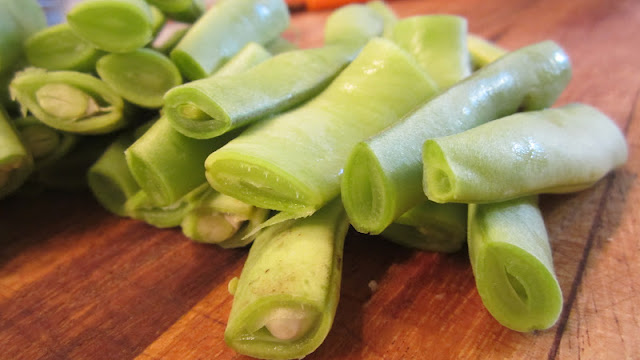It's a paella for September's DK challenge!
I have never even tasted paella before but heard about this Spanish staple dish a lot and that's why I was super excited about paella challenge. And that's why I have jumped into paella online research. The result is below. My goal was to make paella as close to authentic Valencian version as possible. Many thanks to the host of this challenge, Inma, for a great paella guidance also.
PAELLA
For 8-10 servings:
1/2 rabbit
4-5 skinless boneless chicken thighs cut in bite sizes
10 raw shrimp
10 clams
10 mussels
10-15 flat green beans
2 c frozen green peas
1 red bell pepper cut in strips
5-7 garlic cloves
1/2-1 cup fresh beans (cranberry or lima)
3 fresh tomatoes, grated
1 tsp pimenton (smocked sweet spanish paprika)
few saffron threads
3 c bomba rice
10-12 or so cups of water
1 sprig of rosemary
olive oil
salt
- Briefly cook clams and mussels in a boiling water. Remove them on a plate, set aside. Reserve cooking liquid.
- In your paella pan, add olive oil and briefly stir fry red pepper. Remove it from a pan and set aside.
- Add rabbit and chicken pieces to the pan and cook until caramelized. Move them on a sides of pan.
- Add both beans in a middle of pan and cook for about 5-7 minutes, stirring. Add crushed garlic, stir and move to the sides of paella pan.
- In a middle of pan, add pureed tomato and cook for about 2 minutes. Add pimenton, stir and cook for another minute.
- Add reserved liquid from clams and mussels and add more water to have total 12 cups of liquid. Let it boil on a medium heat for about 30-40 minutes.
- Add dry rice in a cross-pattern (see picture below). Throw some saffron threads. Carefully but thoroughly stir all together. Cook for 7 minutes.
- Add frozen peas, stir-fried pepper onto the surface of paella. Arrange mussels and clams on a top of paella in a pretty manner. Place rosemary sprig in a middle and let it cook on a medium-low heat until all water evaporates and crust (socarrat) form in a bottom of a pan.
Some conclusions and discoveries along-the-way
- There is no need to stick to "authentic" ingredient list (besides the authentic recipe below, I have already made two other paellas, not "real" ones, which were great also).
- Don't be shy on olive oil, it will help you to create the best part of the paella, socarrat. It's a crust on a bottom of your pan.
- Make sure you use absolutely the freshest seafood and clean your mussels and clams thoroughly.
- It's the best to use paella pan for paella. Although not having one should not stop you from trying to cook paella. You biggest, flat-bottomed skillet will do descent paella for you too!
- Make sure you keep your pan on a heat until socarrat forms on a bottom - use you nose and ears to have this process under control :)
*********************************************************************************************************************************
IN PICTURES
Blog-checking lines: Our Daring Cooks’ September 2012 hostess was Inma of la Galletika. Inma brought us a taste of Spain and challenged us to make our very own delicious Paella!





























